Rule 1: The most important rule is stock
selection. Stocks have to be large blue chip companies with
strong dividends, solid balance sheets, low P/E ratios, good
cash flow, low debt levels and reasonable payout ratios.
This may seem like a tall order, but these stocks do exist.
Jason has studied my 7 rules
and believes that RIM is a stock he is sold on. Sadly though
RIM does not meet my rules as there is no dividend,
but it does have good cash flow, low debt levels, low P/E
ratio, a good balance sheet BUT a declining market
share and profit margins. All in all it would not be my
choice to own. However for the sake of my example I shall
continue.
Rule 2: Set reasonable guidelines as to
the quantity of stock and dollar amounts you want to invest
in any one stock. 15% of your total stock portfolio in one
stock is probably more than enough for most people.
Jason has committed $40,000
which is 15% of his overall stock portfolio so he feels he
has met those guidelines.
Rule 3: After
setting your guidelines as to the amount of stock you wish
to purchase, average into that quantity over time, to take
advantage of pullbacks. If not a Canadian retirement
account, average into stocks through selling naked puts.
Jason broke rule number 3
right at the outset by jumping in and buying 300 shares
rather than averaging into the stock over time. He did
though believe he has bought on a pullback which occurred
just a few sessions earlier. Looking at the above chart I
would agree he bought near the low for the past 6 months.
But by jumping in and buying 300 shares right away he has
only $6400.00 left to invest. This will not buy him any
shares in RIM at this point. Meanwhile this is a retirement
account and he cannot sell naked puts (as he lives in Canada
and tax laws are somewhat medieval when it comes to options
in Canadian RRSPs). His only choice is covered calls.
Rule 4: Use the selling of puts to generate
income while waiting for a decline in stocks. Consider
laddering your naked puts if required in order to keep to
the strike point you originally selected. For example if you
wanted to be in a stock at 30.00 and the stock rises to
45.00, you may have to go out 6 to 12 months to continue selling
naked puts at the 30.00 strike. Remember that stocks move
around a lot more than analysts might have you believe. A
sudden run-up in a stock can be followed by just as dramatic
a downturn.
Jason cannot do naked puts,
but the same effect could have been created by buying stock
at different levels and selling covered calls at different
strikes, which basically means Jason would have laddered
himself into the stock and reduced his cost per share over
time through covered calls.
Rule 5: If your stock declines dramatically,
research the stock to determine if the fundamentals have not
changed. If they have not, you could consider rolling down
your covered calls and going further out in time. You can
also consider placing a collar on your stock. (I will post
another article on collars soon). Try not to sell below your
cost basis however which can lock you into a loss situation.
Jason doesn't understand or
like collars. He is not an options person and does not
understand covered calls. But he is willing to learn.
However upon researching his stock he determines that the
fundamentals of RIM have changed since his purchase. RIM now
has serious competitors. Market share is declining.
Competitors have newer technology available. Competitors
products seem more trendy. Security questions have also come
up which are costing RIM more money. RIM is spending
billions of research trying to catch up. All of this should
tell Jason that RIM may be a bad investment. But he is
determined to get his capital back.
Rule 6: I believe in keeping 30% of my
portfolio in cash instruments in case my stocks should
decline or a new opportunity presents itself. If you examine
my
Royal Bank trade
or my Sunlife
trade, you can see that my returns hinged completely on
being secure in the belief that I could average down and add
to my position as the stock declined. If I had not been able
to do this with confidence, then my return would have been
greatly reduced. So while Sunlife and Royal Bank saw
dramatic declines along with other financial stocks, the
fundamentals of both companies remained solid, making the
decision to average down, easy.
Jason didn't do this at all.
He is almost fully invested. At this point all he has is the
$6400.00 in cash and the stock in his retirement account
which is not marginable (cannot be loaned against).
Rule 7: After averaging down, commencing
selling covered calls immediately in order to protect the
stock you just purchased from further declines and attempt
to generate income to reduce your overall cost basis on all
the shares you have purchased. If you look at my Sunlife trades
you can see that I averaged down a number of times as the
stock declined. I then immediately sold covered calls and if
my cost basis was too high for covered calls, I sell covered
calls on the most recent stock purchased.
Jason is ready to do this. So
let's see how he can fare: No commissions are taken into
account. Always use a full discount broker. Option prices
shown are actual prices available on the respective day.
Position Summary:
Original Capital Invested -
$33,600.00
Additional Capital Available To Invest - $6,400.00
Now holding 3 covered calls - strike: OCT $70
Oct 8 Stock Price - $64.00 -
Jason sells 3 covered calls for Oct $70.00 - Income is $3.90
a share due to the high volatility which is beyond 54 on the
VIX.
Oct $70 strike - Covered Call
Income - $1170.00
Capital now available to invest - $6400.00 + $1170.00 =
$7570.00
Jason now buys 100 shares of RIM at $64.00 and sells the OCT
$64 Covered Call for $6.20
Oct $64 strike - Covered Call Income - $620.00
Position Summary:
STOCK:
Sep
12 08 Bought 300 shares @ 112.00 - (holding 3 CC Oct 70
against)
Oct 8 08 Bought 100 shares @ 64.00 - (holding 1 CC OCT 64
against)
Covered Calls:
3
covered calls -OCT 70 @ 3.90
1
covered call - OCT 64 @ 6.20
Capital available: 1790.00
THIS IS APPLYING RULE #7 - SELL COVERED CALLS
IMMEDIATELY to protect the stock just purchased from further
declines and attempt to generate income to reduce the
overall cost basis on all the shares purchased.
OCT 17 2008 - Expiration: RIM
Closes $70.25
Jason is exercised of all
shares
Capital available Oct 16 08 - $1790.00
300
X 70 = $21,000.00
100 X 64 = $6400.00
Capital Available: $29190.00
. In Canada as it is a retirement account there are no
tax implications for being exercised repeatedly or buying
back into the same stock. One good advantage of retirement
accounts. This should also be the case in the US with
retirement accounts. Total
capital now available- $27400
from stock exercised + $1790 = 29190.00
On the Monday Oct 20 the stock
falls from $71.11 to $64.88 which is 8.7%. It is obvious to
anyone including Jason that we are in the midst of a market
panic. There is no need to rush in and buy all the stock
here. Instead he picks up 100 shares and sells a call.
Now Jason will apply Rule 3: Average
into stocks over time to take advantage of pullbacks.
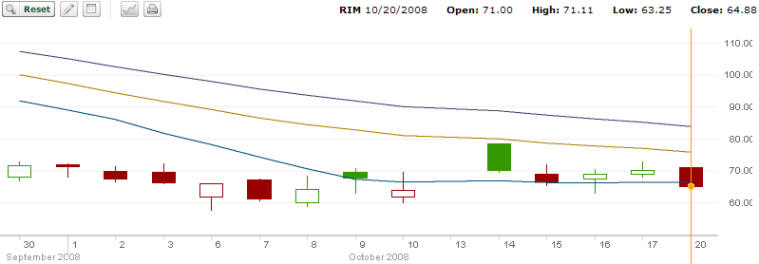
OCT 20 2008: Buy 100 shares of
RIM at $64.88 - SELL 1 COVERED CALL NOV $66.00 for $5.55
Capital still to invest -
$23,257.00
OCT 21 2008: Buy 100 shares of
RIM at $61.54 - SELL 1 COVERED CALL NOV $62.00 for $5.40
Capital still to invest -
$17,643.00
On October 22 the stock closed
at $60.52 which meant selling a Nov 62 covered call. Jason
already has a $62.00 covered call so he does not do any
buying today.
OCT 23 2008: Buy 100 shares of
RIM at $58.19 - SELL 1 COVERED CALL NOV $60 for $5.25
Capital still to invest -
$12,349.00
OCT 24 2008: Buy 100 shares of
RIM at $52.00 - SELL 1 COVERED CALL NOV $54.00 for $6.90.
Capital still to invest -
$7,839.00
OCT 24 2008: Buy 100 shares of
RIM at 54.39 - SELL 1 COVERED CALL NOV $56.00 for
$6.20
Capital still to invest -
$3020.00
Position Summary:
Starting Capital Oct 17 2008: $29190.00
STOCK HELD:
Oct 20 08 Bought 100 shares @ 64.88 (holding 1 CC Nov 66
against)
Oct 21 08 Bought 100 shares @ 61.54 (holding 1 CC Nov 62
against)
Oct 23 08 Bought 100 shares @ 58.19 (holding 1 CC Nov 60
against)
Oct 24 08 Bought 100 shares @ 52.00 (holding 1 CC Nov 54
against)
Oct 24 08 Bought 100 shares @ 54.39 (holding 1 CC Nov 56
against)
COVERED CALLS HELD:
1
covered call - NOV 66 @5.55
1
covered call - NOV 62 @ 5.40
1
covered call - NOV 60 @ 5.25
1 covered call - NOV 54 @6.90
1
covered call - NOV 56 @ 6.20
Capital available: $3020.00
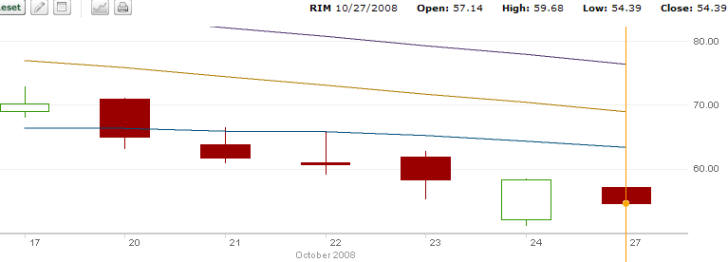
Above is the chart for those
wild October days. Call premiums were all over the place as
volatility kept climbing each day.
However Jason is now holding
November calls on 500 shares of stock, that range from
$54.00 to $66.00.
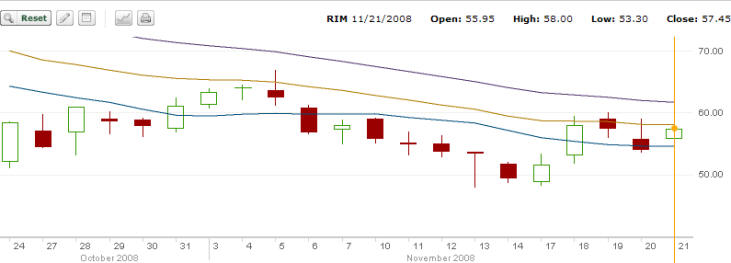
Above is the stock chart for
the days leading up to Nov 21 2008. On that day the stock
closed at $57.45.
NOV 21 2008: Expiration: RIM
closed at $57.45
Jason is exercised of Nov 54
and Nov 56.
Total capital now available- $14,020.00
Covered calls to sell again- 1 X $66 1 X $62 1 X
$60
Position Summary:
Starting Capital Prior to Nov 21 2008: $3020.00
STOCK HELD:
Oct 20 08 Bought 100 shares @ 64.88
Oct 21 08 Bought 100 shares @ 61.54
Oct 23 08 Bought 100 shares @ 58.19
COVERED CALLS HELD:
1
covered call - NOV 66 expired
1
covered call - NOV 62 expired
1
covered call - NOV 60 expired
Capital available Nov 21 2008: $14020.00
November 24 2008: The
following Monday RIM ranged from 59.26 to 55.27
Jason sold 1 DEC 66 call for
2.75 1 DEC 62 calls for 4.10 and 1 DEC 60 calls
for $5.70
Total capital now available -
$14,020.00 + 1255.00 = $15275.00
Now Jason has to decide when
to buy next. It's actually simpler than it seems. Jason
should buy on down days when the stock moves into a lower
range. For example, look at the chart below. On Nov 24th RIM
traded pretty well in the same range as expiry. Not a lot of
reason to buy 100 shares. Next day though RIM moved lower.
Jason buys 100 shares on Nov 25.
November 25 2008: RIM closes
at 50.77 - Jason buy 100 shares at 50.77 and sells a DEC 52
Covered Call for 5.10
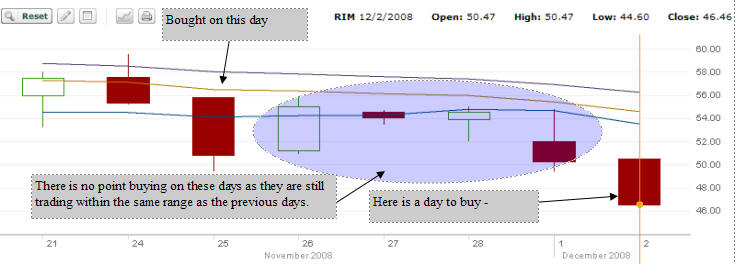
The next 4 days RIM stays
within the same range as Nov 25. Therefore there is no
reason to buy on those days, but On Dec 2 RIM moves lower
again. Jason buys another 100 shares on Dec 2.
December 2 2008: Buys 100
shares at $45.00 - Jason sells a Dec $46.00 covered call for
$6.05
Total Capital now available -
$6813.00 which is enough for another 100 shares.
The strategy though is to hold
it for a move lower. Over the next trading sessions you can
see that RIM did not fall so the capital was never used.
Position Summary:
Starting Capital After Nov 21 2008: $14020.00
STOCK HELD:
Oct 20 08 Bought 100 shares @ 64.88 (holding 1 CC Dec 66
against)
Oct 21 08 Bought 100 shares @ 61.54
(holding 1 CC Dec 62 against)
Oct 23 08 Bought 100 shares @ 58.19
(holding 1 CC Dec 60 against)
Nov 25 08 Bought 100 shares @ 50.77 (holding 1 CC Dec 52
against)
Dec 2 08 Bought 100 shares @ 45.00 (holding 1 CC Dec
46 against)
COVERED CALLS HELD:
1
covered call - DEC 66 @ 2.75
1
covered call - DEC 62 @ 4.10
1
covered call - DEC 60 @ 5.70
1 covered call - DEC 52 @ 5.10
1 covered call - DEC 46. @ 6.05
Capital available Dec 2 2008: $6813.00
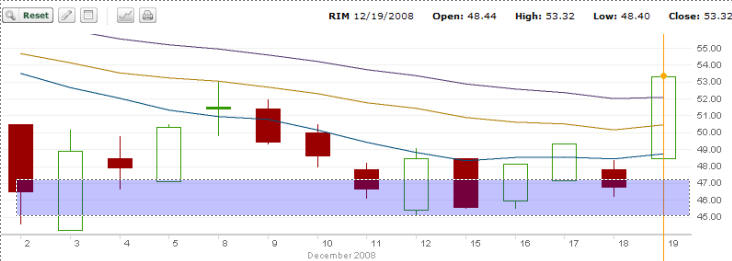
DECEMBER 19 2008 - Expiration:
RIM Closes at $53.32.
Jason is exercised of Dec $52
and $46.00
Total capital now available- $16,613.00
Covered calls to sell again- 1 X $66 1 X $62
1 X $60
Position Summary:
Starting Capital Before DEC 19 2008: $6813.00
STOCK HELD:
Oct
20 08 Bought 100 shares @ 64.88
Oct 21 08 Bought 100 shares @ 61.54
Oct 23 08 Bought 100 shares @ 58.19
COVERED CALLS HELD:
1
covered call - DEC 66 @ expired
1
covered call - DEC 62 @ expired
1
covered call - DEC 60 @ expired
Capital available Dec 20 2008: $16613.00
Below is RIM for the days
after Dec 19 expiration:
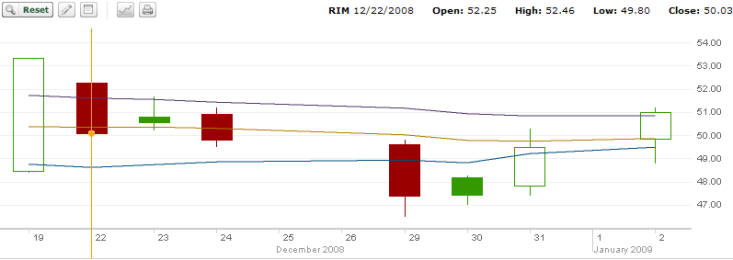
On Dec 22 Jason Sells 1
Covered Call for JAN $60.00 at 1.75 - Sell 1 X FEB $62.00
for 1.80 and 1 X FEB $66.00 for .50
Total capital available -
$17,018.00
On Dec 22 the stock closes at
$50.03 - Jason Buys 100 shares at $50.03 and sells Jan 52
Covered Call for $5.10
Note how the premiums are
beginning to decrease as volatility in the market is
reducing.
On Dec 23 and Dec 24 the stock
stays within the same Range and Jason does not buy any
shares.
On Dec 29 the stock falls to
$46.50 before closing to $47.36- Jason buys 100 shares at
$47.36 and sells 1 January $50.00 covered call for $4.90
Position Summary:
Starting Capital DEC 20 2008: $16613.00
STOCK HELD:
Oct
20 08 Bought 100 shares @ 64.88 (holding 1 CC Feb 66
against)
Oct 21 08 Bought 100 shares @ 61.54 (holding 1 CC Feb 62
against)
Oct 23 08 Bought 100 shares @ 58.19 (holding 1 CC Jan 60
against)
Dec 22 08 Bought 100 shares @ 50.03
(holding 1 CC Jan 52 against)
Dec 29 08 Bought 100 shares @ 47.36
(holding 1 CC Jan 50 against)
COVERED CALLS HELD:
1
covered call - FEB 66 @ .50
1
covered call - FEB 62 @ 1.80
1
covered call - JAN 60 @ 1.75
1 covered call - JAN 52 @ 5.10
1 covered call - JAN 50 @ 4.90
Capital available Dec 29 2008: $8279.00
Over the next few days the
stock stays in the same range and Jason does not buy any
more shares.
By Jan 5 RIM is above 50.00
and closes at $53.17. With the stock in a new range, Jason
buys 100 shares today at $52.00 and sells 1 covered call for
Jan $54.00 for $4.10.
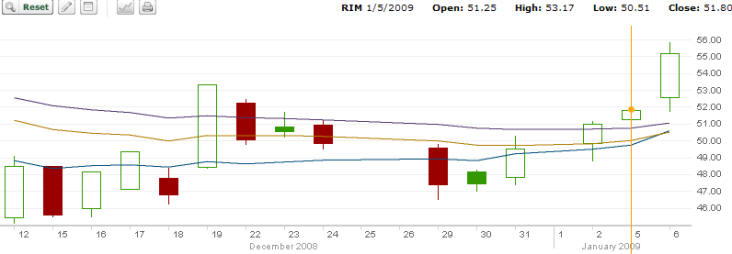
Position Summary:
Starting Capital DEC 20 2008: $16613.00
STOCK HELD:
Oct 20 08 Bought 100 shares @ 64.88 (holding 1 CC Feb 66
against)
Oct 21 08 Bought 100 shares @ 61.54 (holding 1 CC Feb 62
against)
Oct 23 08 Bought 100 shares @ 58.19 (holding 1 CC Jan 60
against)
Dec 22 08 Bought 100 shares @ 50.03
(holding 1 CC Jan 52 against)
Dec 29 08 Bought 100 shares @ 47.36
(holding 1 CC Jan 50 against)
Jan 5 09 Bought 100 shares @ 52.00
(holding 1 CC Jan 54 against)
COVERED CALLS HELD:
1
covered call - FEB 66 @ .50
1
covered call - FEB 62 @ 1.80
1
covered call - JAN 60 @ 1.75
1 covered call - JAN 52 @ 5.10
1 covered call - JAN 50 @ 4.90
1 covered call - JAN 54 @ 4.10
Capital available JAN 5 2009: $3489.00
JANUARY 16 2009 - Expiration:
RIM Closes at $63.75
Jason is exercised of JAN
$60.00, JAN $54.00, JAN $52.00 and JAN $50.00.
Total capital now available- $25,089.00
Covered calls left - 1 X FEB $66 and 1 X FEB $62
Below is RIM for the days
leading up to the Jan 16 2009 expiration:
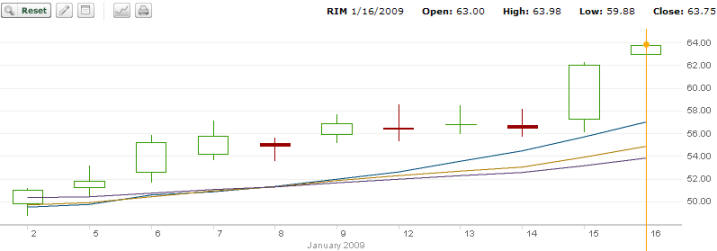
Position Summary:
Starting Capital JAN 17 2009: $25089.00
STOCK HELD:
Oct 20 08 Bought 100 shares @ 64.88 (holding 1 CC Feb 66
against)
Oct 21 08 Bought 100 shares @ 61.54 (holding 1 CC Feb 62
against)
COVERED CALLS HELD:
1
covered call - FEB 66 @ .50
1
covered call - FEB 62 @ 1.80
Capital available JAN 17 2009: $25089.00
Below is the RIM chart following Jan 16
options expiry. On Jan 20 Jason buys 100 shares at $63.00
and the stock soars to $66.00. He sells 1 X FEB $64 covered
call for $7.90. On Jan 26 the stock falls to $60.50. Jason
buys 100 shares as the stock falls, at $61.00 and sells 1 X FEB $62 covered call
for $6.55. On Jan 29 the stock moved from $66.25 to $67.10
and Jason buys 100 shares at $66.50 and sells 1 X FEB $68.00
covered call for $3.80.
Position Summary:
Starting Capital JAN 17 2009: $25089.00
STOCK HELD:
Oct 20 08 Bought 100 shares @ 64.88 (holding 1 CC Feb 66
against)
Oct 21 08 Bought 100 shares @ 61.54 (holding 1 CC Feb 62
against)
Jan 20 09 Bought 100 shares @ 63.00 (holding 1 CC Feb 64
against)
Jan 26 09 Bought 100 shares @ 61.00 (holding 1 CC Feb 62
against)
Jan 29 09 Bought 100 shares @ 66.50 (holding 1 CC Feb 68
against)
COVERED CALLS HELD:
1
covered call - FEB 66 @ .50
1
covered call - FEB 62 @ 1.80
1 covered call - FEB 64 @ 7.90
1 covered call - FEB 62 @ 6.55
1 covered call - FEB 68 @ 3.80
Capital available JAN 29 2009: $7864.00
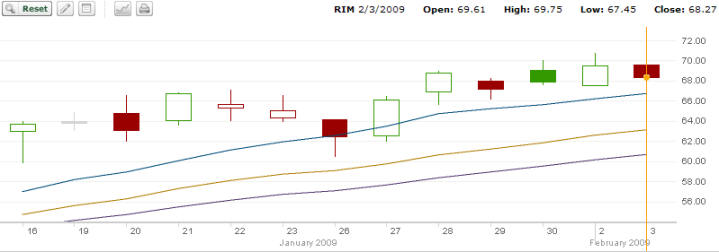
FEBRUARY 19 2009 - Expiration:
RIM Closes at $51.30
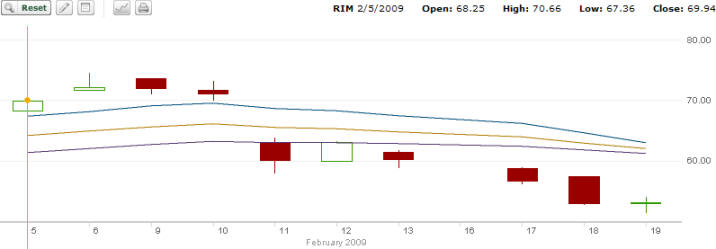
Jason is exercised of no
shares and can resell all his covered calls.
Position Summary:
Starting Capital FEB 19 2009: $7864.00
STOCK HELD:
Oct 20 08 Bought 100 shares @ 64.88
Oct 21 08 Bought 100 shares @ 61.54
Jan 20 09 Bought 100 shares @ 63.00
Jan 26 09 Bought 100 shares @ 61.00
Jan 29 09 Bought 100 shares @ 66.50
COVERED CALLS HELD:
1
covered call - FEB 66 @ expired
1
covered call - FEB 62 @ expired
1 covered call - FEB 64 @ expired
1 covered call - FEB 62 @ expired
1 covered call - FEB 68 @ expired
Capital available FEB 19 2009: $7864.00
Over the next few days here
are the covered call premiums earned:
FEB 20 Sells 1 Covered Call
APR $60.00 for 3.90
FEB 20 Sells 1 Covered Call APR $62.00 for $3.10
FEB 23 Buys 100 shares at
$46.83
FEB 23 Sells 1 Covered Call MAR $50.00 for $4.90
FEB 26 Sells 1 Covered Call
APR $64 for $1.40
Mar 17 Sells 1 Covered Call
Apr $66 for $1.15
MAR 17 sells 1 Covered Call
Apr $68 for .50
Position Summary:
Starting Capital FEB 19 2009: $7864.00
STOCK HELD:
Oct 20 08 Bought 100 shares @ 64.88 (holding 1 CC Apr 66
against)
Oct 21 08 Bought 100 shares @ 61.54 (holding 1 CC Apr 62
against)
Jan 20 09 Bought 100 shares @ 63.00 (holding 1 CC Apr 64
against)
Jan 26 09 Bought 100 shares @ 61.00 (holding 1 CC Apr 60
against)
Jan 29 09 Bought 100 shares @ 66.50 (holding 1 CC Apr 68
against)
Feb
23 09 Bought 100 shares @ 46.83 (holding 1 CC Mar 50
against)
COVERED CALLS HELD:
1
covered call - APR 66 @ 1.15
1
covered call - APR 64 @ 1.40
1 covered call - APR 60 @ 3.90
1 covered call - APR 62 @ 3.10
1 covered call - APR 68 @ .50
1
covered call - MAR 50 @ 4.90
Capital available MAR 17 2009: $4676.00
MARCH 20 2009 - Expiration:
RIM Closes at $51.30
Jason has just 1 covered call
in Mar and is exercised at 50.00
Position Summary:
Starting Capital MAR 17 2009: $4676.00
STOCK HELD:
Oct 20 08 Bought 100 shares @ 64.88 (holding 1 CC Apr 66
against)
Oct 21 08 Bought 100 shares @ 61.54 (holding 1 CC Apr 62
against)
Jan 20 09 Bought 100 shares @ 63.00 (holding 1 CC Apr 64
against)
Jan 26 09 Bought 100 shares @ 61.00 (holding 1 CC Apr 60
against)
Jan 29 09 Bought 100 shares @ 66.50 (holding 1 CC Apr 68
against)
COVERED CALLS HELD:
1
covered call - APR 66 @ 1.15
1
covered call - APR 64 @ 1.40
1 covered call - APR 60 @ 3.90
1 covered call - APR 62 @ 3.10
1 covered call - APR 68 @ .50
1 covered call - MAR 50 @ exercised
Capital available MAR 21 2009: $9676.00
Over the next few days Jason does the following and the
chart below shows the next few days in March 2009.
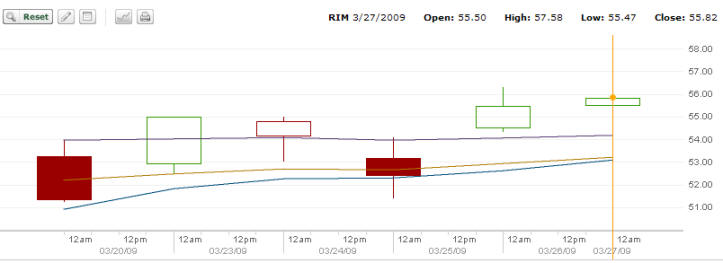
March 25 2009 Buys 100 shares
at 52.39 and sells 1 Covered Call April $54.00 for $5.55
By April 1 the entire stock
market was climbing rapidly and on Apr 3 RIM hit a high of $75.00.
Position Summary:
Starting Capital MAR 21 2009: $9676.00
STOCK HELD:
Oct 20 08 Bought 100 shares @ 64.88 (holding 1 CC Apr 66
against)
Oct 21 08 Bought 100 shares @ 61.54 (holding 1 CC Apr 62
against)
Jan 20 09 Bought 100 shares @ 63.00 (holding 1 CC Apr 64
against)
Jan 26 09 Bought 100 shares @ 61.00 (holding 1 CC Apr 60
against)
Jan 29 09 Bought 100 shares @ 66.50 (holding 1 CC Apr 68
against)
Mar 25 09 Bought 100 shares @ 52.39 (holding 1 CC Apr 54
against)
COVERED CALLS HELD:
1
covered call - APR 66 @ 1.15
1
covered call - APR 64 @ 1.40
1 covered call - APR 60 @ 3.90
1 covered call - APR 62 @ 3.10
1 covered call - APR 68 @ .50
1 covered call - APR 54 @ 5.55
Capital available Apr 4 2009: $4992.00
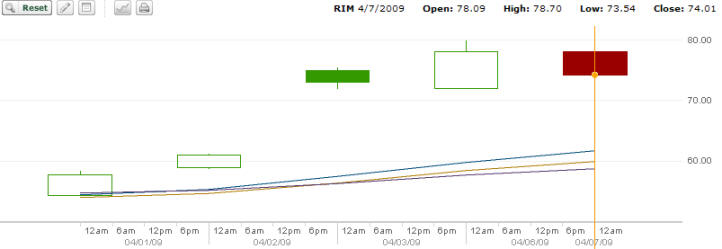
APRIL 17 2009 - Expiration:
RIM Closes at $83.35
Jason is exercised of all
April positions:
Position Summary:
Starting Capital APR 4 2009: $4992.00
STOCK HELD:
Oct 20 08 Bought 100 shares @ 64.88
Oct 21 08 Bought 100 shares @ 61.54
Jan 20 09 Bought 100 shares @ 63.00
Jan 26 09 Bought 100 shares @ 61.00
Jan 29 09 Bought 100 shares @ 66.50
Mar 25 09 Bought 100 shares @ 52.39
COVERED CALLS HELD:
1
covered call - APR 66 @ exercised
1
covered call - APR 64 @ exercised
1 covered call - APR 60 @ exercised
1 covered call - APR 62 @ exercised
1 covered call - APR 68 @ exercised
1 covered call - APR 54 @ exercised
Capital available Apr 17 2009: $42392
Jason has his capital returned. Total profit was $2392.00
for a profit of 5.9%
Yet RIM as of March 2011 has
not recovered to the original purchase price of $112.00.
THE SECOND TRADE
TAKES THE EXACT SAME POSITIONS BUT INSTEAD NAKED PUTS AND
COVERED CALLS ARE USED.
This trade
is just an example to show various trading strategies and
how they can be applied to assist in recovery of capital
despite a declining stock. I have done my best to review all
the calculations. If you note an error please contact me and
I will adjust the calculations for any miscalculation.